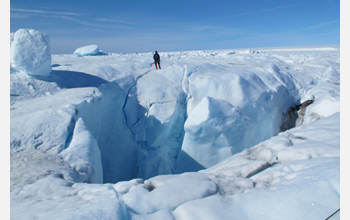Multimedia Gallery
Extreme Melting of Greenland Ice Sheet
Marco Tedesco, assistant professor in the Department of Earth and Atmospheric Sciences at the City College of New York, stands on the edge of one of four moulins (drainage holes) he and his team found at the bottom of a supraglacial lake during an expedition to Greenland in the summer of 2011.
During the expedition, which preceded the onset of the melt season, Tedesco and a team of researchers collected data from the Jakobshavn Isbræ glacier in western Greenland. Analysis of the data found that the Greenland ice sheet can experience extreme melting even when temperatures do not hit record highs. Tedesco's findings suggest that glaciers could undergo a self-amplifying cycle of melting and warming that would be difficult to halt.
Data was gathered on the ground with microwave satellite recordings and from a model of the ice sheet. The team recorded data on air temperatures, wind speed, exposed ice and its movement, the emergence of streams and lakes of melt water on the surface, and the water's eventual draining away beneath the glacier.
The model showed that melting between June and August was well above the average for 1979 to 2010. In fact, melting in 2011 was the third most extensive since 1979, lagging behind only 2010 and 2007. The "mass balance," or amount of snow gained minus the snow and ice that melted away, ended up tying last year's record values.
The research was supported by the National Science Foundation (grant ARC 09-09388) and the NASA Cryosphere Program. The World Wildlife Fund is acknowledged for supporting fieldwork activities. To learn more, see the CUNY news release Extreme Melting on Greenland Ice Sheet, Reports CCNY Team. (Date of Image: June 2011)
Credit: Marco Tedesco, EAS Department, City College of New York
Images and other media in the National Science Foundation Multimedia Gallery are available for use in print and electronic material by NSF employees, members of the media, university staff, teachers and the general public. All media in the gallery are intended for personal, educational and nonprofit/non-commercial use only.
Images credited to the National Science Foundation, a federal agency, are in the public domain. The images were created by employees of the United States Government as part of their official duties or prepared by contractors as "works for hire" for NSF. You may freely use NSF-credited images and, at your discretion, credit NSF with a "Courtesy: National Science Foundation" notation.
Additional information about general usage can be found in Conditions.
Also Available:
Download the high-resolution JPG version of the image. (3 MB)
Use your mouse to right-click (Mac users may need to Ctrl-click) the link above and choose the option that will save the file or target to your computer.



